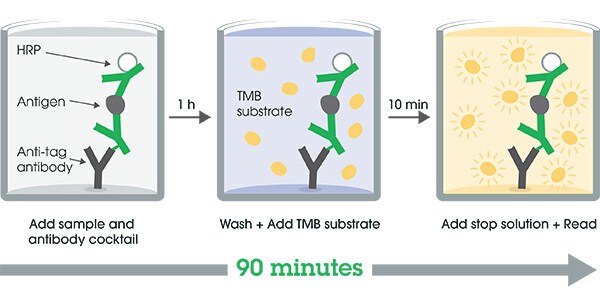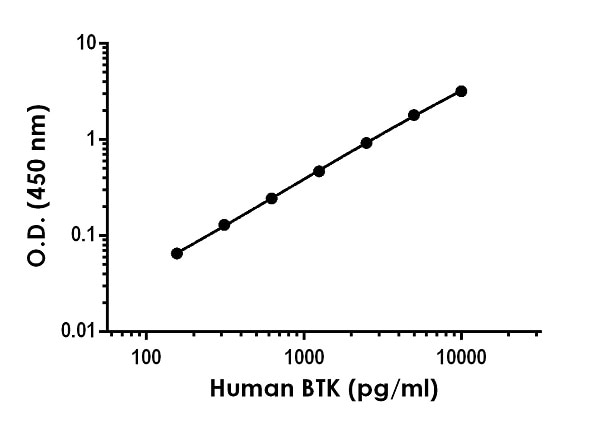Human BTK ELISA Kit (ab277089)
Key features and details
- One-wash 90 minute protocol
- Sensitivity: 29 pg/ml
- Range: 156.25 pg/ml - 10000 pg/ml
- Sample type: Cell Lysate
- Detection method: Colorimetric
- Assay type: Sandwich (quantitative)
- Reacts with: Human
Overview
-
Product name
Human BTK ELISA Kit
See all BTK kits -
Detection method
Colorimetric -
Precision
Intra-assay Sample n Mean SD CV% Extract 8 4.2% Inter-assay Sample n Mean SD CV% Extract 3 4.99% -
Sample type
Cell Lysate -
Assay type
Sandwich (quantitative) -
Sensitivity
29 pg/ml -
Range
156.25 pg/ml - 10000 pg/ml -
Recovery
Sample specific recovery Sample type Average % Range Cell Lysate 100 92% - 112% -
Assay time
1h 30m -
Assay duration
One step assay -
Species reactivity
Reacts with: Human -
Product overview
Human BTK ELISA kit (ab277089) is a single-wash 90 min sandwich ELISA designed for the quantitative measurement of Human BTK protein in human cell extracts. It uses our proprietary SimpleStep ELISA® technology. Quantitate Human BTK with 29 pg/mL sensitivity.
SimpleStep ELISA® technology employs capture antibodies conjugated to an affinity tag that is recognized by the monoclonal antibody used to coat our SimpleStep ELISA® plates. This approach to sandwich ELISA allows the formation of the antibody-analyte sandwich complex in a single step, significantly reducing assay time. See the SimpleStep ELISA® protocol summary in the image section for further details. Our SimpleStep ELISA® technology provides several benefits:
-Single-wash protocol reduces assay time to 90 minutes or less
-High sensitivity, specificity and reproducibility from superior antibodies
-Fully validated in biological samples
-96-wells plate breakable into 12 x 8 wells stripsA 384-well SimpleStep ELISA® microplate (ab203359) is available to use as an alternative to the 96-well microplate provided with SimpleStep ELISA® kits.
-
Notes
BTK, Bruton’s tyrosine kinase, is critical for B-cell development. It sits at a major nexus for downstream signaling via phosphorylation cascades as well as phosphatidylinositol messaging. It is known to be responsible for oncogenic signaling that allows proliferation of B-cell leukemias. The antibodies in this kit were raised against the human full-length recombinant protein.
Abcam has not and does not intend to apply for the REACH Authorisation of customers’ uses of products that contain European Authorisation list (Annex XIV) substances.
It is the responsibility of our customers to check the necessity of application of REACH Authorisation, and any other relevant authorisations, for their intended uses. -
Platform
Pre-coated microplate (12 x 8 well strips)
Properties
-
Storage instructions
Store at +4°C. Please refer to protocols. -
Components 1 x 96 tests 10X Human BTK Capture Antibody 1 x 600µl 10X Human BTK Detector Antibody 1 x 600µl 10X Wash Buffer PT (ab206977) 1 x 20ml 5X Cell Extraction Buffer PTR (ab193970) 1 x 10ml Antibody Diluent 4BI 1 x 6ml Human BTK Lyophilized Recombinant Protein 2 vials Plate Seals 1 unit Sample Diluent NS (ab193972) 1 x 12ml SimpleStep Pre-Coated 96-Well Microplate (ab206978) 1 unit Stop Solution 1 x 12ml TMB Development Solution 1 x 12ml -
Research areas
-
Function
Plays a crucial role in B-cell ontogeny. Transiently phosphorylates GTF2I on tyrosine residues in response to B-cell receptor cross-linking. Required for the formation of functional ARID3A DNA-binding complexes. -
Involvement in disease
Defects in BTK are the cause of X-linked agammaglobulinemia (XLA) [MIM:300755]; also known as X-linked agammaglobulinemia type 1 (AGMX1) or immunodeficiency type 1 (IMD1). XLA is a humoral immunodeficiency disease which results in developmental defects in the maturation pathway of B-cells. Affected boys have normal levels of pre-B-cells in their bone marrow but virtually no circulating mature B-lymphocytes. This results in a lack of immunoglobulins of all classes and leads to recurrent bacterial infections like otitis, conjunctivitis, dermatitis, sinusitis in the first few years of life, or even some patients present overwhelming sepsis or meningitis, resulting in death in a few hours. Treatment in most cases is by infusion of intravenous immunoglobulin.
Defects in BTK may be the cause of X-linked hypogammaglobulinemia and isolated growth hormone deficiency (XLA-IGHD) [MIM:307200]; also known as agammaglobulinemia and isolated growth hormone deficiency or Fleisher syndrome or isolated growth hormone deficiency type 3 (IGHD3). In rare cases XLA is inherited together with isolated growth hormone deficiency (IGHD). -
Sequence similarities
Belongs to the protein kinase superfamily. Tyr protein kinase family. TEC subfamily.
Contains 1 Btk-type zinc finger.
Contains 1 PH domain.
Contains 1 protein kinase domain.
Contains 1 SH2 domain.
Contains 1 SH3 domain. -
Post-translational
modificationsAutophosphorylated on Tyr-223 and Tyr-551. Phosphorylation of Tyr-223 may create a docking site for a SH2 containing protein. -
Cellular localization
Cytoplasm. Membrane. Nucleus. - Information by UniProt
-
Alternative names
- Agammaglobulinaemia tyrosine kinase
- AGMX 1
- AGMX1
see all -
Database links
- Entrez Gene: 695 Human
- Omim: 300300 Human
- SwissProt: Q06187 Human
- Unigene: 159494 Human
Images
-
-
The BTK standard curve was prepared as described in Section 10. Raw data values are shown in the table. Background-subtracted data values (mean +/- SD) are graphed.
-
 Interpolated concentrations of native BTK in human 50 ?g/mL Raji and 100 ?g/mL Ramos cell extract load.
Interpolated concentrations of native BTK in human 50 ?g/mL Raji and 100 ?g/mL Ramos cell extract load.The concentrations of BTK were measured in duplicate and interpolated from the BTK standard curve and corrected for sample dilution. The interpolated dilution factor corrected values are plotted (mean +/- SD, n=2). The mean BTK concentration was determined to be 5,508.56 pg/mL in Raji cell extract and 5,046.75 pg/mL in Ramos cell extract.
-
To learn more about the advantages of recombinant antibodies see here.













